7.2: Intergroup Relations
- Last updated
- Save as PDF
- Page ID
- 104070

- Erika Gutierrez, Janét Hund, Shaheen Johnson, Carlos Ramos, Lisette Rodriguez, & Joy Tsuhako
- Long Beach City College, Cerritos College, & Saddleback College via ASCCC Open Educational Resources Initiative (OERI)
\( \newcommand{\vecs}[1]{\overset { \scriptstyle \rightharpoonup} {\mathbf{#1}} } \)
\( \newcommand{\vecd}[1]{\overset{-\!-\!\rightharpoonup}{\vphantom{a}\smash {#1}}} \)
\( \newcommand{\dsum}{\displaystyle\sum\limits} \)
\( \newcommand{\dint}{\displaystyle\int\limits} \)
\( \newcommand{\dlim}{\displaystyle\lim\limits} \)
\( \newcommand{\id}{\mathrm{id}}\) \( \newcommand{\Span}{\mathrm{span}}\)
( \newcommand{\kernel}{\mathrm{null}\,}\) \( \newcommand{\range}{\mathrm{range}\,}\)
\( \newcommand{\RealPart}{\mathrm{Re}}\) \( \newcommand{\ImaginaryPart}{\mathrm{Im}}\)
\( \newcommand{\Argument}{\mathrm{Arg}}\) \( \newcommand{\norm}[1]{\| #1 \|}\)
\( \newcommand{\inner}[2]{\langle #1, #2 \rangle}\)
\( \newcommand{\Span}{\mathrm{span}}\)
\( \newcommand{\id}{\mathrm{id}}\)
\( \newcommand{\Span}{\mathrm{span}}\)
\( \newcommand{\kernel}{\mathrm{null}\,}\)
\( \newcommand{\range}{\mathrm{range}\,}\)
\( \newcommand{\RealPart}{\mathrm{Re}}\)
\( \newcommand{\ImaginaryPart}{\mathrm{Im}}\)
\( \newcommand{\Argument}{\mathrm{Arg}}\)
\( \newcommand{\norm}[1]{\| #1 \|}\)
\( \newcommand{\inner}[2]{\langle #1, #2 \rangle}\)
\( \newcommand{\Span}{\mathrm{span}}\) \( \newcommand{\AA}{\unicode[.8,0]{x212B}}\)
\( \newcommand{\vectorA}[1]{\vec{#1}} % arrow\)
\( \newcommand{\vectorAt}[1]{\vec{\text{#1}}} % arrow\)
\( \newcommand{\vectorB}[1]{\overset { \scriptstyle \rightharpoonup} {\mathbf{#1}} } \)
\( \newcommand{\vectorC}[1]{\textbf{#1}} \)
\( \newcommand{\vectorD}[1]{\overrightarrow{#1}} \)
\( \newcommand{\vectorDt}[1]{\overrightarrow{\text{#1}}} \)
\( \newcommand{\vectE}[1]{\overset{-\!-\!\rightharpoonup}{\vphantom{a}\smash{\mathbf {#1}}}} \)
\( \newcommand{\vecs}[1]{\overset { \scriptstyle \rightharpoonup} {\mathbf{#1}} } \)
\( \newcommand{\vecd}[1]{\overset{-\!-\!\rightharpoonup}{\vphantom{a}\smash {#1}}} \)
\(\newcommand{\avec}{\mathbf a}\) \(\newcommand{\bvec}{\mathbf b}\) \(\newcommand{\cvec}{\mathbf c}\) \(\newcommand{\dvec}{\mathbf d}\) \(\newcommand{\dtil}{\widetilde{\mathbf d}}\) \(\newcommand{\evec}{\mathbf e}\) \(\newcommand{\fvec}{\mathbf f}\) \(\newcommand{\nvec}{\mathbf n}\) \(\newcommand{\pvec}{\mathbf p}\) \(\newcommand{\qvec}{\mathbf q}\) \(\newcommand{\svec}{\mathbf s}\) \(\newcommand{\tvec}{\mathbf t}\) \(\newcommand{\uvec}{\mathbf u}\) \(\newcommand{\vvec}{\mathbf v}\) \(\newcommand{\wvec}{\mathbf w}\) \(\newcommand{\xvec}{\mathbf x}\) \(\newcommand{\yvec}{\mathbf y}\) \(\newcommand{\zvec}{\mathbf z}\) \(\newcommand{\rvec}{\mathbf r}\) \(\newcommand{\mvec}{\mathbf m}\) \(\newcommand{\zerovec}{\mathbf 0}\) \(\newcommand{\onevec}{\mathbf 1}\) \(\newcommand{\real}{\mathbb R}\) \(\newcommand{\twovec}[2]{\left[\begin{array}{r}#1 \\ #2 \end{array}\right]}\) \(\newcommand{\ctwovec}[2]{\left[\begin{array}{c}#1 \\ #2 \end{array}\right]}\) \(\newcommand{\threevec}[3]{\left[\begin{array}{r}#1 \\ #2 \\ #3 \end{array}\right]}\) \(\newcommand{\cthreevec}[3]{\left[\begin{array}{c}#1 \\ #2 \\ #3 \end{array}\right]}\) \(\newcommand{\fourvec}[4]{\left[\begin{array}{r}#1 \\ #2 \\ #3 \\ #4 \end{array}\right]}\) \(\newcommand{\cfourvec}[4]{\left[\begin{array}{c}#1 \\ #2 \\ #3 \\ #4 \end{array}\right]}\) \(\newcommand{\fivevec}[5]{\left[\begin{array}{r}#1 \\ #2 \\ #3 \\ #4 \\ #5 \\ \end{array}\right]}\) \(\newcommand{\cfivevec}[5]{\left[\begin{array}{c}#1 \\ #2 \\ #3 \\ #4 \\ #5 \\ \end{array}\right]}\) \(\newcommand{\mattwo}[4]{\left[\begin{array}{rr}#1 \amp #2 \\ #3 \amp #4 \\ \end{array}\right]}\) \(\newcommand{\laspan}[1]{\text{Span}\{#1\}}\) \(\newcommand{\bcal}{\cal B}\) \(\newcommand{\ccal}{\cal C}\) \(\newcommand{\scal}{\cal S}\) \(\newcommand{\wcal}{\cal W}\) \(\newcommand{\ecal}{\cal E}\) \(\newcommand{\coords}[2]{\left\{#1\right\}_{#2}}\) \(\newcommand{\gray}[1]{\color{gray}{#1}}\) \(\newcommand{\lgray}[1]{\color{lightgray}{#1}}\) \(\newcommand{\rank}{\operatorname{rank}}\) \(\newcommand{\row}{\text{Row}}\) \(\newcommand{\col}{\text{Col}}\) \(\renewcommand{\row}{\text{Row}}\) \(\newcommand{\nul}{\text{Nul}}\) \(\newcommand{\var}{\text{Var}}\) \(\newcommand{\corr}{\text{corr}}\) \(\newcommand{\len}[1]{\left|#1\right|}\) \(\newcommand{\bbar}{\overline{\bvec}}\) \(\newcommand{\bhat}{\widehat{\bvec}}\) \(\newcommand{\bperp}{\bvec^\perp}\) \(\newcommand{\xhat}{\widehat{\xvec}}\) \(\newcommand{\vhat}{\widehat{\vvec}}\) \(\newcommand{\uhat}{\widehat{\uvec}}\) \(\newcommand{\what}{\widehat{\wvec}}\) \(\newcommand{\Sighat}{\widehat{\Sigma}}\) \(\newcommand{\lt}{<}\) \(\newcommand{\gt}{>}\) \(\newcommand{\amp}{&}\) \(\definecolor{fillinmathshade}{gray}{0.9}\)History of Intergroup Relations
Intergroup relations (relationships between different groups of people) range along a spectrum between tolerance and intolerance. The most tolerant form of intergroup relations is pluralism, in which no distinction is made between marginalized groups and dominant groups, but instead there’s equal standing. At the other end of the continuum are genocide, expulsion, and segreation—stark examples of intolerant intergroup relations.
Patterns of Intergroup Relations: African Americans
- Extermination/Genocide: The deliberate, systematic killing of an entire people or nation (e.g. TransAtlantic Slave Trade, lynching).
- Expulsion/ Population Transfer: The dominant group expels the marginalized group (e.g. Trans Atlantic Slave Trade).
- Internal Colonialism: The dominant group exploits the marginalized group (e.g. slavery, sharecropping).
- Segregation: The dominant group structures physical, unequal separation of two groups in residence, workplace & social functions (e.g. Jim Crow Law).
- Sepratism: The marginalized group desires physical separation of two groups in residence, workplace & social functions (e.g. Black Nationalists).
- Fusion/ Amalgamation: Race-ethnic groups combine to form a new group (e.g. intermarriage, biracial/bicultural children).
- Assimilation: The process by which a marginalized individual or group takes on the characteristics of the dominant group (e.g. working and schooling in predominantly white institutions).
- Pluralism/ Multiculturalism: Various race-ethnic groups in a society have mutual respect for one another, without prejudice or discrimination (e.g. Caribbean & African immigrant enclaves).
The Trans-Atlantic Slave Trade
The trans-Atlantic slave trade was the largest long-distance coerced movement of people in history and, prior to the mid-nineteenth century, formed the major demographic well-spring for the re-peopling of the Americas following the collapse of the American Indian population. Cumulatively, as late as 1820, nearly four Africans had crossed the Atlantic for every European, and, given the differences in the sex ratios between European and African migrant streams, about four out of every five females that traversed the Atlantic were from Africa. From the late fifteenth century, the Atlantic Ocean, once a formidable barrier that prevented regular interaction between those peoples inhabiting the four continents it touched, became a commercial highway that integrated the histories of Africa, Europe, and the Americas for the first time. As Figure 7.2.1 suggests, slavery and the slave trade were the linchpins of this process, illustrating intergroup consequences of genocide, expulsion, and internal colonialism. With the decline of the Native American population, labor from Africa formed the basis of the exploitation of the gold and agricultural resources of the export sectors of the Americas, with sugar plantations absorbing well over two thirds of slaves carried across the Atlantic by the major European and Euro-American powers.
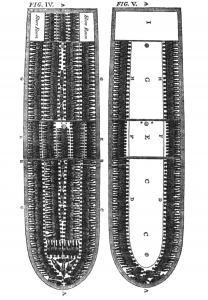
The Middle Passage
Whatever the route taken, conditions on board reflected the outsider status of those held below deck. No European, whether convict, indentured servant, or destitute free migrant, was ever subjected to the environment which greeted the typical African slave upon embarkation. The sexes were separated, kept naked, packed close together, and the men were chained for long periods. No less than 26% of those on board were classed as children, a ratio that no other pre-twentieth century migration could come close to matching. Except for the illegal period of the trade when conditions at times became even worse, slave traders typically packed two slaves per ton. While a few voyages sailing from Upper Guinea could make a passage to the Americas in three weeks, the average duration from all regions of Africa was just over two months.
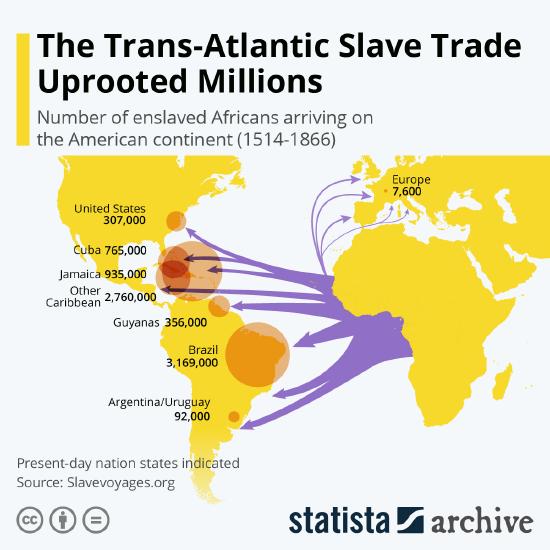
Most of the space on a slave ship was absorbed by casks of water. Crowded vessels sailing to the Caribbean from West Africa first had to sail south before turning north-west and passing through the doldrums. In the nineteenth century, improvements in sailing technology eventually cut the time in half, but mortality remained high in this period because of the illegal nature of the business. Throughout the slave trade era, filthy conditions ensured endemic gastro-intestinal diseases, and a range of epidemic pathogens that, together with periodic breakouts of violent resistance, meant that between 12 and 13 percent of those embarked did not survive the voyage, which is why it is important to connect the trans-Atlantic slave trade to genocide, the systematic killing of an entire people. Modal mortality fell well below mean mortality as catastrophes on a relatively few voyages drove up average shipboard deaths. Crew mortality as a percentage of those going on board, matched slave mortality over the course of the voyage, but as slaves were there for a shorter period of time than the crew, mortality rates for slaves (over time) were the more severe. The eighteenth-century world was violent and life-expectancy was short everywhere given that the global mortality revolution was still over the horizon, but the human misery quotient generated by the expulsion or forced movement, forced migration, of millions of people in slave ships cannot have been matched by any other human activity.
Slavery
There is no starker illustration of the dominant-subordinate group relationship than that of slavery, which further connects to internal colonialism, an inhumane exploitation of Black Americans by the dominant group, slave-holding white Americans. In order to justify their severely discriminatory behavior, slave-holders and their supporters had to view Blacks as innately inferior, thus from a racist ideology lens as explained in Chapter 1.2. Slaves were denied even the most basic rights of citizenship, a crucial factor for slave-holders and their supporters. Slavery poses an extreme example of conflict theory’s perspective on race relations; the dominant group needed complete control over the subordinate group in order to maintain its power. Whippings, executions, rapes, denial of schooling, and health care were all permissible and widely practiced.
Slavery eventually became an issue over which the nation divided into geographically and ideologically distinct factions, leading to the Civil War. And while the abolition of slavery on moral grounds was certainly a catalyst for war, it was not the only driving force. Students of U.S. history will know that the institution of slavery was crucial to the Southern economy, whose production of crops like rice, cotton, and tobacco relied on the virtually limitless and cheap labor that slavery provided. In contrast, the North didn’t benefit economically from slavery, resulting in an economic disparity tied to racial and political issues.
Slave Revolts
Slaves resisted their enslavement in small ways every day, but this resistance did not usually translate into mass uprisings. Slaves understood that the chances of ending slavery through rebellion were slim and would likely result in massive retaliation; many also feared the risk that participating in such actions would pose to themselves and their families. White slave-holders, however, constantly feared uprisings and took drastic steps, including torture and mutilation, whenever they believed that rebellions might be simmering. Gripped by the fear of insurrection, whites often imagined revolts to be in the works even when no uprising actually happened.
At least two major slave uprisings did occur in the antebellum South. In 1811, a major rebellion broke out in the sugar parishes of the booming territory of Louisiana. Inspired by the successful overthrow of the white planter class in Haiti, Louisiana slaves took up arms against planters. Perhaps as many five hundred slaves joined the rebellion, led by Charles Deslondes, a mixed-race slave driver on a sugar plantation owned by Manuel Andry.
The revolt began in January 1811 on Andry’s plantation. Deslondes and other slaves attacked the Andry household, where they killed the slave master’s son (although Andry himself escaped). The rebels then began traveling toward New Orleans, armed with weapons gathered at Andry’s plantation. Whites mobilized to stop the rebellion, but not before Deslondes and the other rebelling slaves set fire to three plantations and killed numerous whites. A small white force led by Andry ultimately captured Deslondes, whose body was mutilated and burned following his execution. Other slave rebels were beheaded, and their heads placed on pikes along the Mississippi River.
The second rebellion, led by the slave Nat Turner, occurred in 1831 in Southampton County, Virginia. Turner had suffered not only from personal enslavement, but also from the additional trauma of having his wife sold away from him. Bolstered by Christianity, Turner became convinced that like Christ, he should lay down his life to end slavery. Mustering his relatives and friends, he began the rebellion August 22, killing scores of whites in the county. Whites mobilized quickly and within forty-eight hours had brought the rebellion to an end. Shocked by Nat Turner’s Rebellion, Virginia’s state legislature considered ending slavery in the state in order to provide greater security. In the end, legislators decided slavery would remain and that their state would continue to play a key role in the domestic slave trade.
Sharecropping
The 13th Amendment to the constitution marked the end of slavery and led to the transition to wage labor. However, this conversion to sharecropping did not entail a new era of economic independence for former slaves but rather a continuation of internal colonialism. While they no longer faced relentless toil under the lash, freed people emerged from slavery without any money and needed farm implements, food, and other basic necessities to start their new lives. Under the sharecropping system, store owners extended credit to farmers under the agreement that the debtors would pay with a portion of their future harvest. However, the creditors charged high interest rates, making it even harder for freed people to gain economic independence.
Throughout the South, sharecropping took root, a crop-lien system that worked to the advantage of landowners. Under the system, freed people rented the land they worked, often on the same plantations where they had been slaves. Some landless whites also became sharecroppers. Sharecroppers paid their landlords with the crops they grew, often as much as half their harvest. Sharecropping favored the landlords and ensured that freed people could not attain independent livelihoods.The year-to-year leases meant no incentive existed to substantially improve the land, and high interest payments siphoned additional money away from the farmers. Sharecroppers often became trapped in a never-ending cycle of debt, unable to buy their own land and unable to stop working for their creditor because of what they owed. The consequences of sharecropping affected the entire South for many generations, severely limiting economic development and ensuring that the South remained an agricultural backwater.
| Items bought by Polly from Presley George | Amount due to Presley George from Polly |
|---|---|
| 4 3/4 Cuts of wool | $3.50 |
| 22 yds. Cloth | $11.00 |
| 5 yds. Thread | $2.50 |
| Boarding for one child | $12.00 |
| 40 bushels of corn | $40.00 |
| Total Payment | $69.00 |
| Amount of work and by whom | Presley George's payment for Polly and her family's work |
|---|---|
| 3 months of work by Polly | $12.00 |
| 4 months of work by Peter (son) | $32.00 |
| 4 months of work by Burrell (son | $16.00 |
| 4 months of work by Siller (daughter) | $9.00 |
| Total Payment | $69.00 |
The excerpt below, extracted from The Life Stories of Undistinguished Americans as Told by Themselves further conveys the blurred line of distinction between slavery and sharecropping, "freedom," further conveying the parallel exploitation in either system:
Slabery an' freedom (Slavery and freedom)
Dey's mos' de same (They're mostly the same)
No difference hahdly (No difference hardly)
Cep' in de name. (Except in the name).
Jim Crow Segregation and African American Life
Jim Crow segregation was a way of life that combined a system of anti-Black laws and race-prejudiced cultural practices. The term Jim Crow is often used as a synonym for racial segregation, particularly in the American South. The Jim Crow South was the era during which local and state laws enforced the legal segregation of white and Black citizens from the 1870s into the 1960s. In the Jim Crow South, it was illegal for Black Americans to ride in the front of public buses, eat at a “whites only” restaurant, or attend a “white” public school.
The term Jim Crow originated from the name of a Black character from early- and mid- nineteenth century American theater. Crows are Black birds, and Crow was the last name of a stock fictional Black character, who was almost always played onstage by a white man in wearing Blackface makeup. Due to the prevalence of this character, "Jim Crow" became a derogatory term for people of African descent.
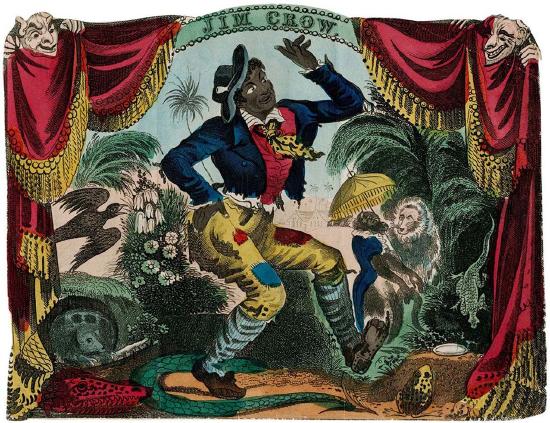
In the South, electoral politics remained a parade of electoral fraud, voter intimidation, and race-baiting. Democratic Party candidates stirred southern whites into frenzies with warnings of “Negro domination” and of Black men violating white women. The region’s culture of racial violence and the rise of lynching as a mass public spectacle accelerated. And as the remaining African American voters threatened the dominance of Democratic leadership in the South, southern Democrats turned to what many white southerners understood as a series of progressive electoral and social reforms—disenfranchisement and segregation. Just as reformers would clean up politics by taming city political machines, white southerners would “purify” the ballot box by restricting Black voting and they would prevent racial strife by legislating the social separation of the races. The strongest supporters of such measures in the South movement were progressive Democrats and former Populists, both of whom saw in these reforms a way to eliminate the racial demagoguery that conservative Democratic party leaders had so effectively wielded. Leaders in both the North and South embraced and proclaimed the reunion of the sections on the basis of a shared Anglo-Saxon, white supremacy. As the nation took up the “white man’s burden” to uplift the world’s racially inferior peoples, the North looked to the South as an example of how to manage non-white populations. The South had become the nation’s racial vanguard.
The question was how to accomplish disfranchisement. The 15th Amendment clearly prohibited states from denying any citizen the right to vote on the basis of race. In 1890 the state of Mississippi took on this legal challenge. A state newspaper called on politicians to devise “some legal defensible substitute for the abhorrent and evil methods on which white supremacy lies.” The state’s Democratic Party responded with a new state constitution designed to purge corruption at the ballot box through disenfranchisement. Those hoping to vote in Mississippi would have to jump through a series of hurdles designed with the explicit purpose of excluding the state’s African American population from political power. The state first established a poll tax, which required voters to pay for the privilege of voting. Second, it stripped the suffrage from those convicted of petty crimes most common among the state’s African Americans. Next, the state required voters to pass a literacy test. Local voting election officials, who were themselves part of the local party machine, were responsible for judging whether voters were able to read and understand a section of the Constitution. In order to protect illiterate whites from exclusion, the so called “understanding clause” allowed a voter to qualify if they could adequately explain the meaning of a section that was read to them. In practice these rules were systematically abused to the point where local election officials effectively wielded the power to permit and deny suffrage at will. The disenfranchisement laws effectively moved electoral conflict from the ballot box, where public attention was greatest, to the voting registrar, where supposedly color-blind laws allowed local party officials to deny the ballot without the appearance of fraud.
Between 1895 and 1908 the rest of the states in the South approved new constitutions including these disenfranchisement tools. Six southern states also added a grandfather clause, which bestowed the suffrage on anyone whose grandfather was eligible to vote in 1867. This ensured that whites who would have been otherwise excluded would still be eligible, at least until it was struck down by the Supreme Court in 1915. Finally, each southern state adopted an all-white primary, excluded Blacks from the Democratic primary, the only political contests that mattered across much of the South.
At the same time that the South’s Democratic leaders were adopting the tools to disenfranchise the region’s Black voters, these same legislatures were constructing a system of racial segregation even more pernicious. While it built on earlier practice, segregation was primarily a modern and urban system of enforcing racial subordination and deference. In rural areas, white and Black southerners negotiated the meaning of racial difference within the context of personal relationships of kinship and patronage. An African American who broke the local community’s racial norms could expect swift personal sanctions that often included violence. The crop lien and convict lease systems were the most important legal tools of racial control in the rural South. Maintaining white supremacy there did not require segregation. Maintaining white supremacy within the city, however, was a different matter altogether. As the region’s railroad networks and cities expanded, so too did the anonymity and therefore freedom of southern Blacks. Southern cities were becoming a center of Black middle class life that was an implicit threat to racial hierarchies. White southerners created the system of segregation as a way to maintain white supremacy in restaurants, theaters, public restrooms, schools, water fountains, train cars, and hospitals. Segregation inscribed the superiority of whites and the deference of Blacks into the very geography of public spaces.
As with disenfranchisement, segregation violated a plain reading of the constitution—in this case the Fourteenth Amendment. Here the Supreme Court intervened, ruling in the Civil Rights Cases (1883) that the Fourteenth Amendment only prevented discrimination directly by states. It did not prevent discrimination by individuals, businesses, or other entities. Southern states exploited this interpretation with the first legal segregation of railroad cars in 1888. In a case that reached the Supreme Court in 1896, New Orleans resident Homer Plessy challenged the constitutionality of Louisiana’s segregation of streetcars. The court ruled against Plessy and, in the process, established the legal principle of separate but equal. Racially segregated facilities were legal provided they were equivalent. In practice this was rarely the case. The court’s majority defended its position with logic that reflected the racial assumptions of the day. “If one race be inferior to the other socially,” the court explained, “the Constitution of the United States cannot put them upon the same plane.” Justice John Harlan, the lone dissenter, countered, “our Constitution is color-blind, and neither knows nor tolerates classes among citizens. In respect of civil rights, all citizens are equal before the law” Harlan went on to warn that the court’s decision would “permit the seeds of race hatred to be planted under the sanction of law.” In their rush to fulfill Harlan’s prophecy, southern whites codified and enforced the segregation of public spaces.
Segregation was built on a fiction—that there could be a white South socially and culturally distinct from African Americans. Its legal basis rested on the constitutional fallacy of “separate but equal” as declared by Plessy v. Ferguson (1896). Southern whites erected a bulwark of white supremacy that would last for nearly sixty years. Segregation and disenfranchisement in the South rejected Black citizenship and relegated Black social and cultural life to segregated spaces. African Americans lived divided lives, acting the part whites demanded of them in public, while maintaining their own world apart from whites. This segregated world provided a measure of independence for the region’s growing Black middle class, yet at the cost of poisoning the relationship between Black and white. Segregation and disenfranchisement created entrenched structures of racism that completed the total rejection of the promises of Reconstruction.
Video \(\PageIndex{5}\): "Plessy v. Ferguson Summary - Quimbee.com." (Close-captioning and other YouTube settings will appear once the video starts.) (Fair Use; Quimbee via YouTube)
And yet, many Black Americans of the Progressive Era fought back. Just as activists such as Ida B Wells worked against southern lynching, Booker T. Washington and W.E.B. DuBois vied for leadership among African American activists, resulting in years of intense rivalry and debated strategies for the uplifting of Black Americans.
Born into the world of bondage in Virginia in 1856, Booker Taliaferro Washington was subjected to the degradation and exploitation of slavery early in life. But Washington also developed an insatiable thirst to learn. Working against tremendous odds, Washington matriculated into Hampton University in Virginia and thereafter established a southern institution that would educate many Black Americans, the Tuskegee Institute. Located in Alabama, Washington envisioned Tuskegee’s contribution to Black life to come through industrial education and vocational training. He believed that such skills would help African Americans to accomplish economic independence while developing a sense of self-worth and pride of accomplishment, even while living within the putrid confines of Jim Crow. Washington poured his life into Tuskegee, and thereby connected with leading white philanthropic interests. Individuals such as Andrew Carnegie, for instance, financially assisted Washington and his educational ventures.
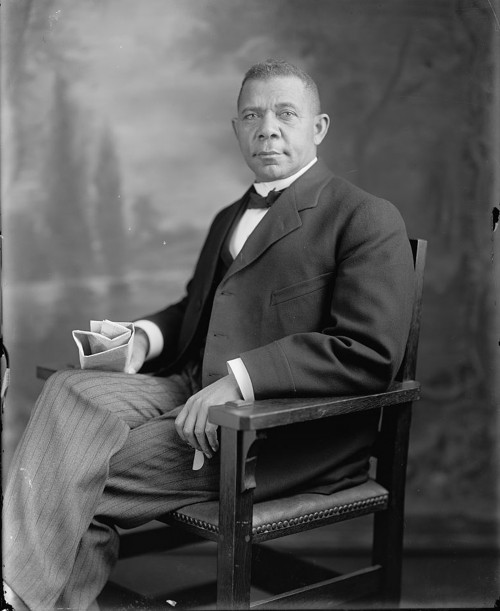
As a leading spokesperson for Black Americans at the turn of the twentieth century, particularly after Frederick Douglass’s exit from the historical stage in early 1895, Washington’s famous Atlanta Compromise speech from that same year encouraged Black Americans to “cast your bucket down” to improve life’s lot under segregation. In the same speech, delivered one year before the Supreme Court’s Plessy decision that legalized segregation under the “separate but equal” doctrine, Washington said to white Americans, “In all things that are purely social we can be as separate as the fingers, yet one as the hand in all things essential to mutual progress.” Both praised as a race leader and pilloried as an accommodationist to America’s unjust racial hierarchy, Washington’s public advocacy of a conciliatory posture towards white supremacy concealed the efforts to which Washington went to assist African Americans in the legal and economic quest for racial justice. In addition to founding Tuskegee, Washington also published a handful of influential books, including the autobiography Up from Slavery (1901). Like Du Bois, Washington was also active in Black journalism, working to fund and support Black newspaper publications, most of which sought to counter Du Bois’s growing influence. Washington died in 1915, during World War I, of ill health in Tuskegee, Alabama.
Speaking decades later, W.E.B. DuBois, referenced at the beginning of this book in Chapter 1.1, claimed Washington had, in his 1895 Compromise speech, “implicitly abandoned all political and social rights. . . I never thought Washington was a bad man ... I believed him to be sincere, though wrong.” Du Bois would directly attack Washington in his classic (1903) The Souls of Black Folk, but at the turn of the century he could never escape the shadow of his longtime rival. “I admired much about him,” Du Bois admitted, “Washington . . . died in 1915. A lot of people think I died at the same time.”
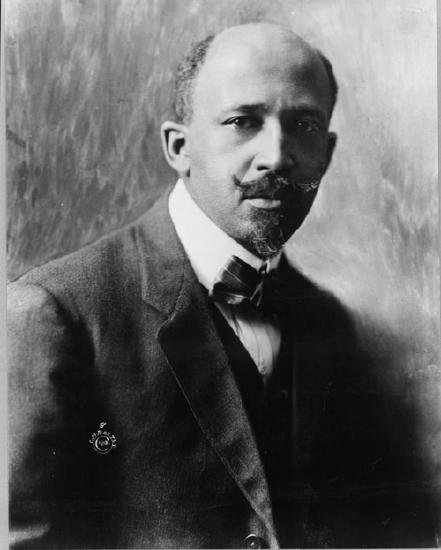
Du Bois’s criticism reveals the politicized context of the Black freedom struggle and exposes the many positions available to Black activists. Born in Great Barrington, Massachusetts, in 1868, W. E. B. Du Bois entered the world as a free person of color three years after the Civil War ended. Raised by a hardworking and independent mother, Du Bois’s New England childhood alerted him to the reality of race even as it invested the emerging thinker with an abiding faith in the power of education. Du Bois graduated at the top of his high school class and attended Fisk University. Du Bois’s sojourn to the South in 1880s left a distinct impression that would guide his life’s work to study what he called the “Negro problem,” the systemic racial and economic discrimination that Du Bois prophetically pronounced would be the problem of the twentieth century. After Fisk, Du Bois’s educational path trended back North, and he attended Harvard, earned his second degree, crossed the Atlantic for graduate work in Germany, and circulated back to Harvard and in 1895—the same year as Washington’s famous Atlanta address—became the first Black American to receive a Ph.D. there. Du Bois ultimately repatriated to Ghana, Africa in 1961, heeding the call of Ghana's first president after independence, Kwame Nkrumah, to edit the Encyclopedia Africana, which he worked on until his death in 1963.
Tulsa Race Massacre
Tulsa’s long history as an important town and later as a city in Oklahoma began with the removal of the Fives Civilized Tribes from the Southeastern United States in the 1830s into Indian Territory (now Oklahoma). One of the Five Tribes, the Muscogee (Creek) settled in the area. In the 1870s, the Perryman family based their sizable cattle ranch in what would become south Tulsa. The town grew slowly, with a rail line arriving in the 1880s. At the dawn of the twentieth century, the discovery of huge oil fields nearby convinced city leaders to market Tulsa as a convenient and enjoyable place to conduct the business and financial sides of the oil industry. Several oil industry companies agreed and established their headquarters there. This spurred economic development in the city as executives built further accommodations for the industry and funded building construction, oil infrastructure, and a growing hospitality industry. The rapid growth of the oil industry resulted in Tulsa earning the nickname “the Oil Capital of the World.” By 1920, Tulsa served as the base for over 400 petroleum companies.
Within this thriving environment, a neighborhood born of both Jim Crow segregation and the booming wealth of Tulsa existed near downtown. The Greenwood District existed because of a smart business transaction on the part of O. W. Gurley, a wealthy and well-connected African American landowner who came to Oklahoma because of the Land Run of 1889. After moving to Tulsa in 1906, he purchased 40 acres of land along the Frisco rail tracks in north Tulsa. As he built a rooming house and several other buildings on this land, Oklahoma officially became a state. The first legislative action, Senate Bill One, established segregation between African Americans and whites throughout the state. Oklahoma implemented a sweeping system of segregation, limiting where African Americans could live and shop in addition to how they traveled and existed in public spaces.
At the same time, the economic success of Tulsa attracted African Americans from within Oklahoma and throughout the US. With few options outside of Greenwood and with entrepreneurs actively developing the district into a self-sustaining economic district, the area increased in both population and variety of goods and services. By 1920 the population in Greenwood reached 11,000. Manual laborers and hospitality workers made up the majority and the foundation of the neighborhood who faced challenging work conditions but relatively livable wages.
Because of Jim Crow laws and a wish to support their community, residents spent their money within Greenwood, feeding the growth of the economy. A wide variety of professionals, entrepreneurs, and workers shared quality school and hospital systems, a public library, hotels, parks, and theaters in Greenwood. During this time, African Americans struggled to gain access to these features of city life because of segregation. The homes in the densely populated district ranged from thrown-together shanties to luxurious multi-story homes on “Professor’s Row.” Greenwood attracted nationally renowned African American leaders and activists such as Booker T. Washington and W. E. B. DuBois. In fact, Booker T. Washington gave Greenwood its nickname: Black Wall Street.
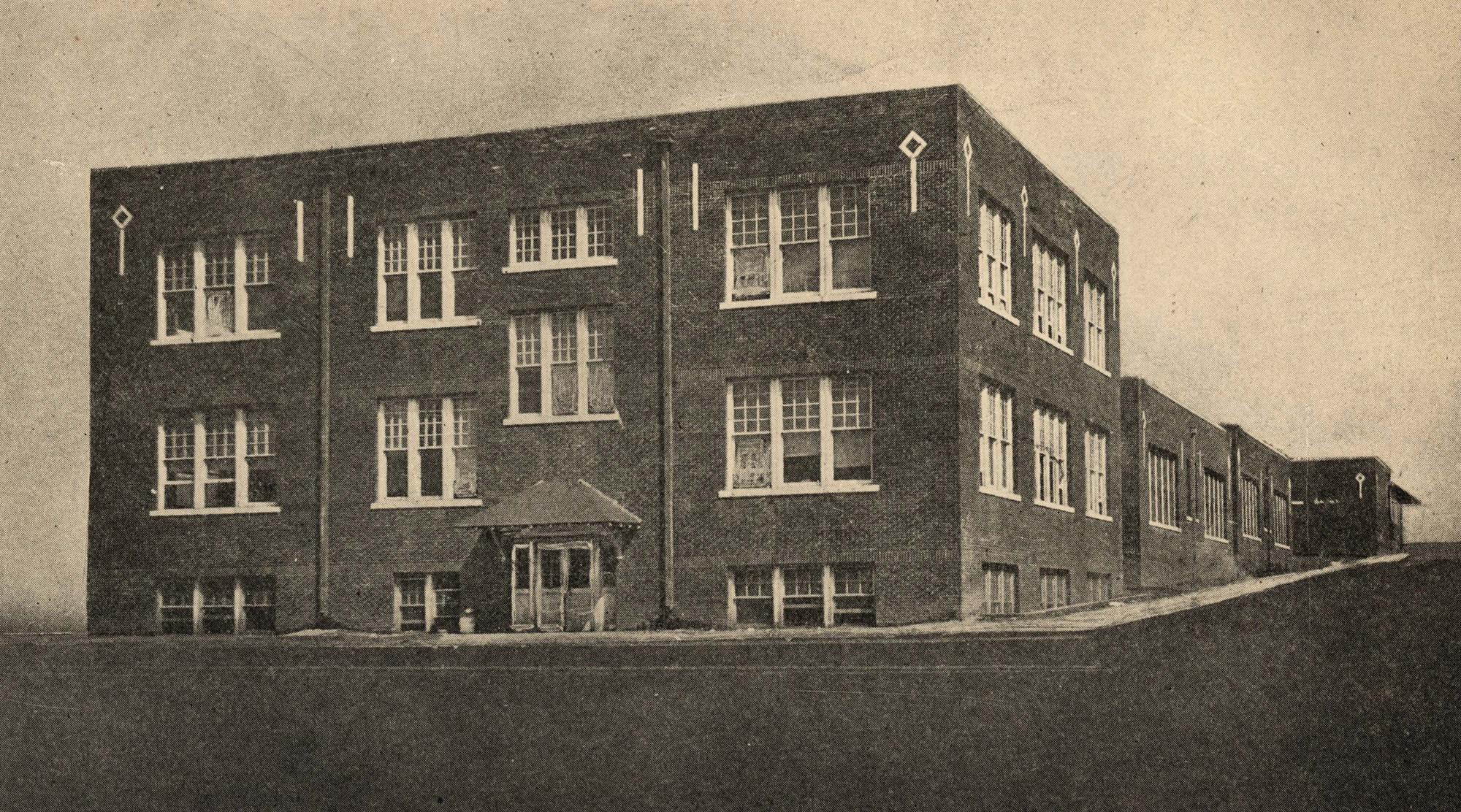
On May 31, hundreds of white Tulsans gathered outside of the Tulsa County Courthouse as the afternoon turned into evening. They sent in a group of men demanding the deputies hand over Dick Rowland, an African American teenage shoe shiner, arrested early on "alleged assault" charge. The sheriff had taken measures to prevent anyone from taking custody of Rowland. At 9 p.m., an armed group of 25 African American men, many of whom were recent World War I veterans, came to the courthouse to offer their assistance in protecting Rowland. The sheriff declined their help and assured the men that the situation remained under control. The group returned to Greenwood. The arrival of the men angered the white mob, which continued to grow in size. It now stood at approximately two thousand. The sheriff took additional precautions and pleaded with the crowd to disperse.
Shortly after 10 p.m., a group of 75 African American men, returned to the courthouse and were once again told to leave. As they departed in a single-file line, a white man attempted to disarm one of the African American men. The man resisted. In the scuffle, the weapon discharged. Both sides exchanged fire.
The African American men engaged in a fighting retreat back to Greenwood as armed whites attacked them. The local police force expanded as the chief deputized 500 white men and boys. Those who did not have weapons went to local pawnshops, hardware stores, and sporting goods stores, breaking in and stealing guns. The targets of the mob evolved from the original armed group to any African American person. Indiscriminate killing began. As both sides reached Greenwood, deadly battles erupted, particularly along the Frisco railroad tracks. In other parts of Greenwood, whites drove into the neighborhood and killed residents from their cars. Some whites began setting fires to property in Greenwood at around 1 a.m. White rioters prevented the fire department from extinguishing the flames.
Some rioters demanded the weapons at the National Guard armory. The guardsmen on duty refused to hand out the weapons. Later, after the authorities officially asked for the assistance of the National Guard, their primary responsibility lay in arresting all of the African Americans in Greenwood and holding them at various locations throughout the city. Another group of guardsmen assisted other whites in attacking groups of remaining African American men who were still defending their property, families, and community.
As dawn approached, approximately 10,000 whites hovered around the edges of Greenwood. Many African Americans remained in their homes, hoping to avoid the conflict and protect their families and property. White men had hauled a machine gun to the top of a grain elevator. At 5:08 a.m., a signal pierced the air. In response to the signal, the machine gunners began firing into Greenwood. The rest of the mob began marching and driving into the neighborhood. Moving from house to house, white rioters broke into homes and businesses and forced the occupants out for internment. Then, they looted the properties.
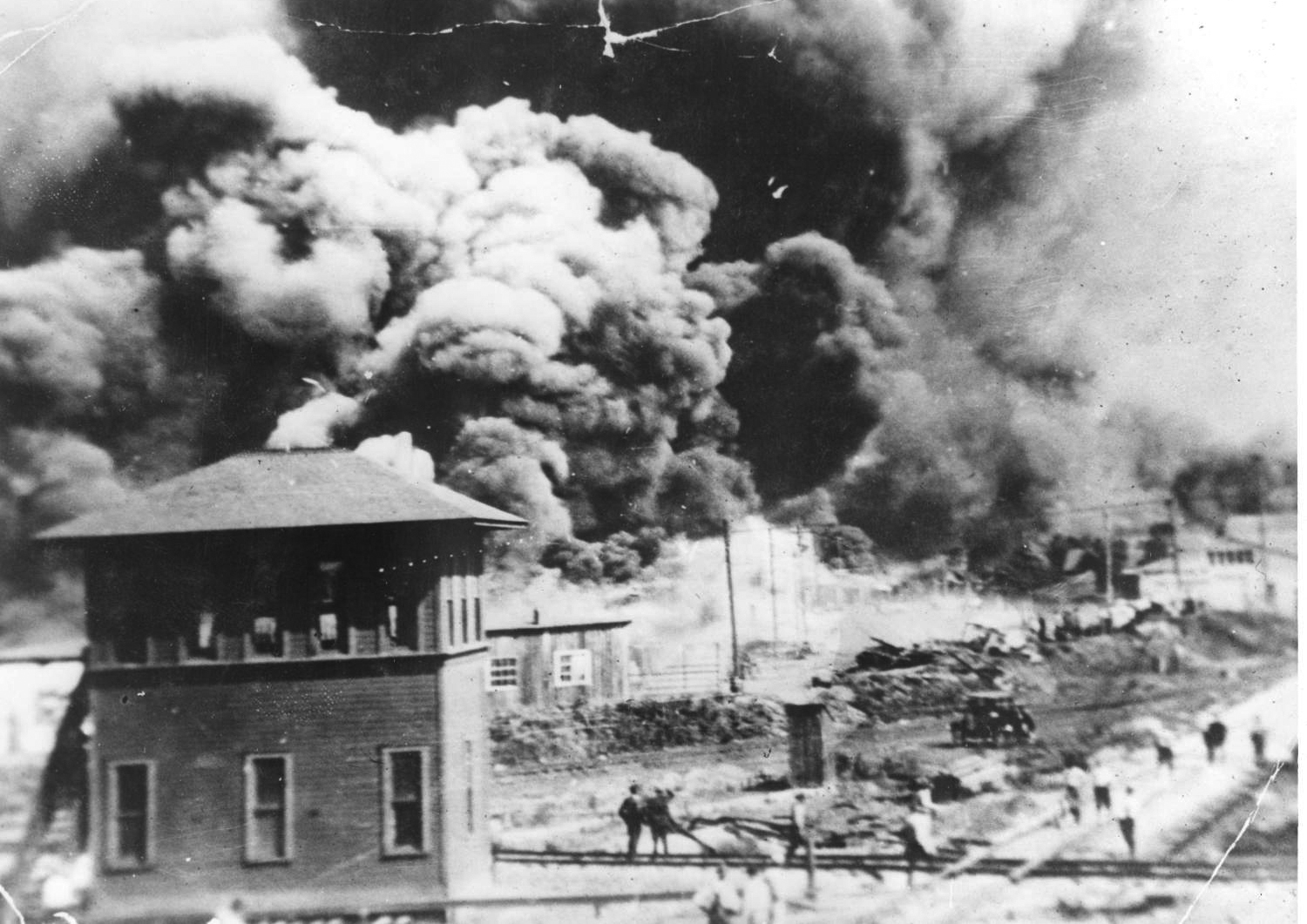
Figure \(\PageIndex{11}\): Tulsa Race Massacre, 1921. (CC PDM 1.0; 1619126 Oklahoma Historical Society Photograph Collection (OHS) via OKHistory)
Deployed at 10 p.m. the night before, one hundred Oklahoma City National Guard troops made their way to Tulsa. Upon their arrival at 9 a.m., their commander secured a declaration of martial law. As more National Guard members entered Greenwood, most of the rioters headed home. The National Guard took custody of the camps and declared order restored at 8 p.m. that evening.
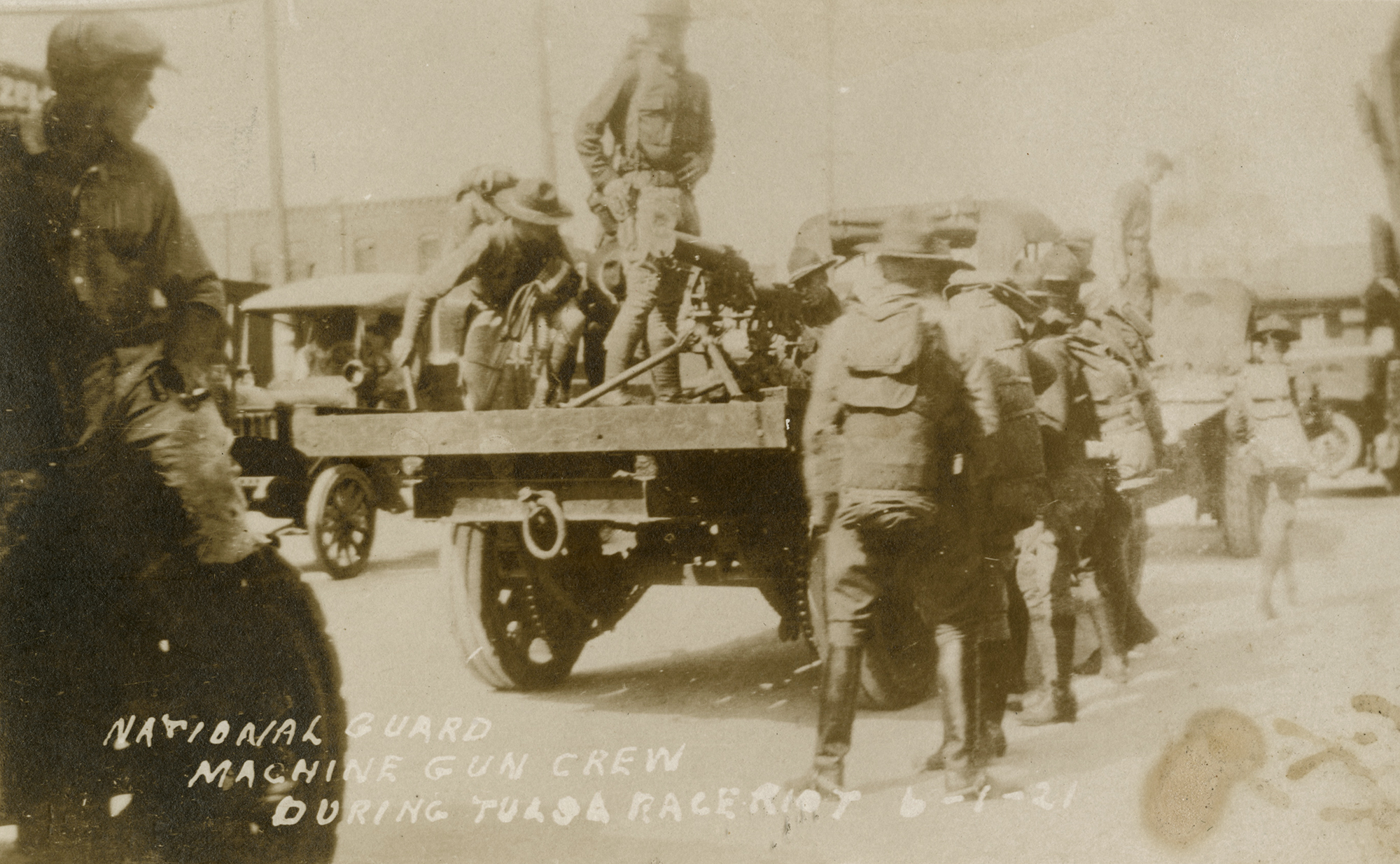
The Tulsa Race Massacre Aftermath
The Internment
By the end of the day, the internment camps held 6,000 African American residents. The next day, authorities moved them to the fairgrounds. The National Guard forced these prisoners, both men and women, to labor. The mayor threatened to arrest anyone refusing work for vagrancy. Authorities required them to clean up the destruction caused by the white rioters. The length of stay varied for most of those imprisoned. Release depended on white employers vouching for their African American workers. After that the city issued passes, called green cards, for them to carry to show their employment. By the middle of June, no one remained in these camps.
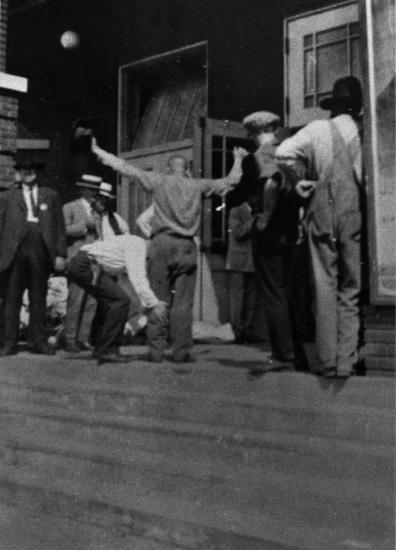
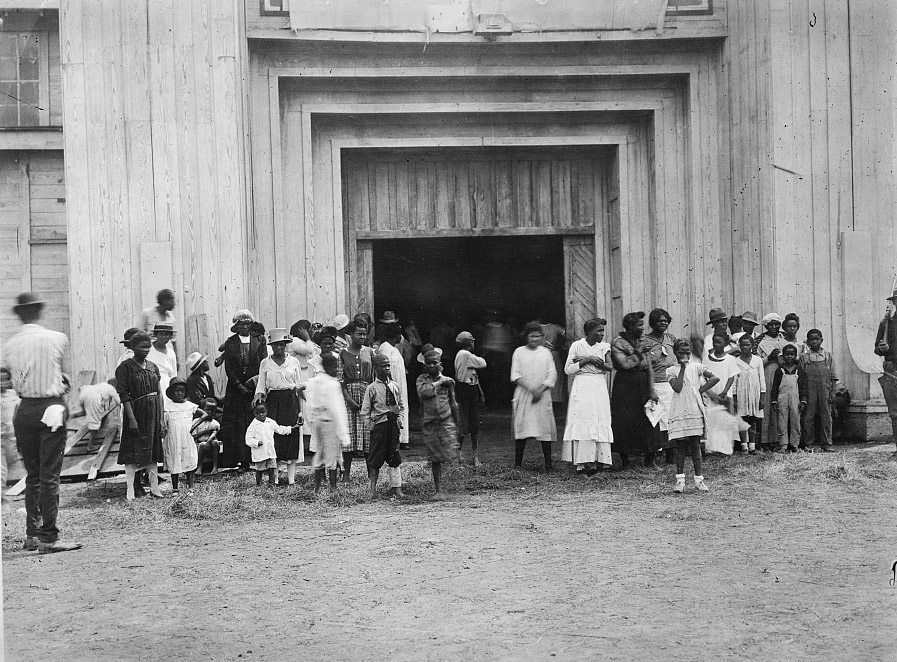
The Uprising Narrative
Within a week the leaders of the major institutions in Tulsa began promoting a narrative that blamed the residents of Greenwood themselves for the violence. The Tulsa Tribune, the state’s attorney general, many ministers, and the mayor advanced this argument. The attorney general, in a speech in Tulsa on June 17, said:
The cause of this riot was not Tulsa. It might have happened anywhere for the Negro is not the same man he was thirty years ago when he was content to plod along his own road accepting the white man as his benefactor. But the years have passed and the Negro has been educated and the race papers have spread the thought of race equality.
The grand jury convened to investigate, followed the attorney general’s lead and concluded in its report:
The crowd assembled about the courthouse being purely spectators and curiosity seekers…There was no mob spirit among the whites, no talk of lynching and no arms. The assembly was quiet until the arrival of armed negroes, which precipitated and was the direct cause of the riot.
The lead attorney for the state used her power to give immunity to any whites who looted homes or murdered African Americans. This remained the dominant narrative until attention to the massacre began to fade outside the African American community in Oklahoma.

Land Issues
In early June, some city officials promised to rebuild and began setting up structures to assist the residents of Greenwood. The city directed donations from across the country to the relief efforts of the Red Cross. They actively refused support for reconstruction from other cities, announcing that restoring the city was strictly a “Tulsa affair,” and the residents of Tulsa would take care of it. By June 3, a trade organization called the Real Estate Exchange floated the idea of not rebuilding, but instead rezoning the neighborhood for industrial purposes. Realtors attempted to get African American landowners to sell but wanted the land at discounted rates. Maurice Willows used his influence to convince African American property owners to keep their land. The city responded by applying a fire code to the area that would make rebuilding too expensive for most individual property owners. Well known attorney and activist, B. C. Franklin, along with I. H. Spears and T. O. Chapelle, encouraged residents to start the rebuilding process even though they faced arrest by doing so. Their lawyers vowed to secure the release of anyone arrested for rebuilding. They filed a suit against the city for taking property without due process. They won the lawsuit, providing the neighborhood a chance to survive.
Another challenge facing residents in their attempt to rebuild lay in the insurance companies’ refusal to pay on claim for damages related to the massacre. Insurance policies contained exemptions from paying for damages related to riots.
The residents of Greenwood rebuilt the neighborhood with very little outside investment or support.
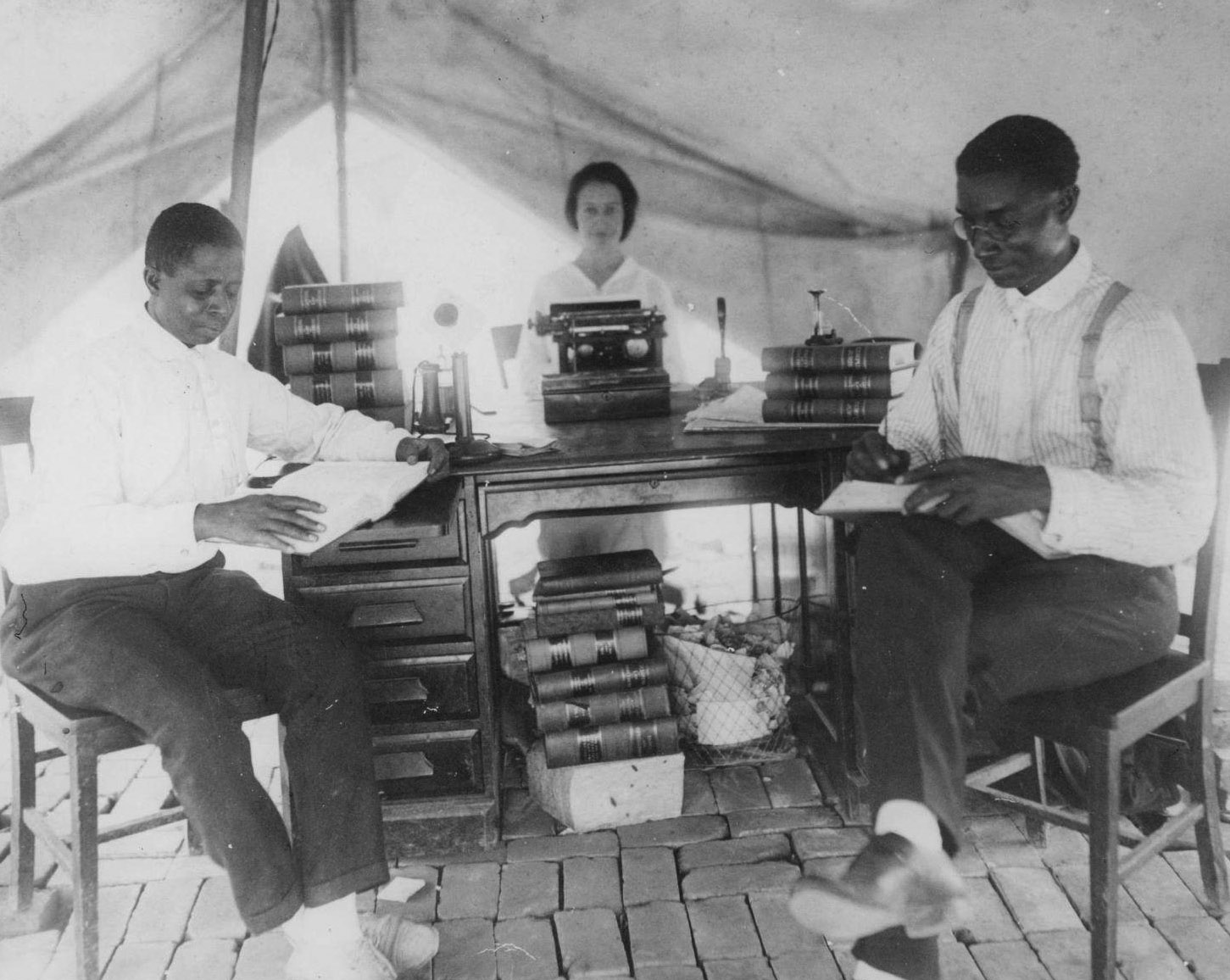
School Segregation
Older battles over racial exclusion also confronted postwar American society. One long-simmering struggle targeted segregated schooling. Since the Supreme Court’s decision in Plessy v. Ferguson (1896), Black Americans, particularly in the American South, had fully felt the deleterious effects of segregated education. Their battle against Plessy for inclusion in American education stretched across half a century when the Supreme Court again took up the merits of “separate but equal.”
On May 17, 1954, after two years of argument, re-argument, and deliberation, Chief Justice Earl Warren announced the Supreme Court’s decision on segregated schooling in Oliver Brown, et al v. Board of Education of Topeka, et al. The court found by a unanimous 9-0 vote that racial segregation violated the Equal Protection Clause of the Fourteenth Amendment. The court’s decision declared, “Separate educational facilities are inherently unequal.” “Separate but equal” was made unconstitutional.
Decades of African American-led litigation, local agitation against racial inequality, and liberal Supreme Court justices made Brown v. Board possible. In the early 1930s, the National Association for the Advancement of Colored People (NAACP) began a concerted effort to erode the legal underpinnings of segregation in the American South. De jure segregation (legal segregation) subjected racial minorities to discriminatory laws and policies. Law and custom in the South hardened anti-Black restrictions. But through a series of carefully chosen and contested court cases concerning education, disfranchisement, and jury selection, NAACP lawyers such as Charles Hamilton Houston, Robert L. Clark, and future Supreme Court Justice Thurgood Marshall undermined Jim Crow’s constitutional underpinnings. Initially seeking to demonstrate that states systematically failed to provide African American students “equal” resources and facilities, and thus failed to live up to Plessy, by the late 1940s activists began to more forcefully challenge the assumptions that “separate” was constitutional at all.
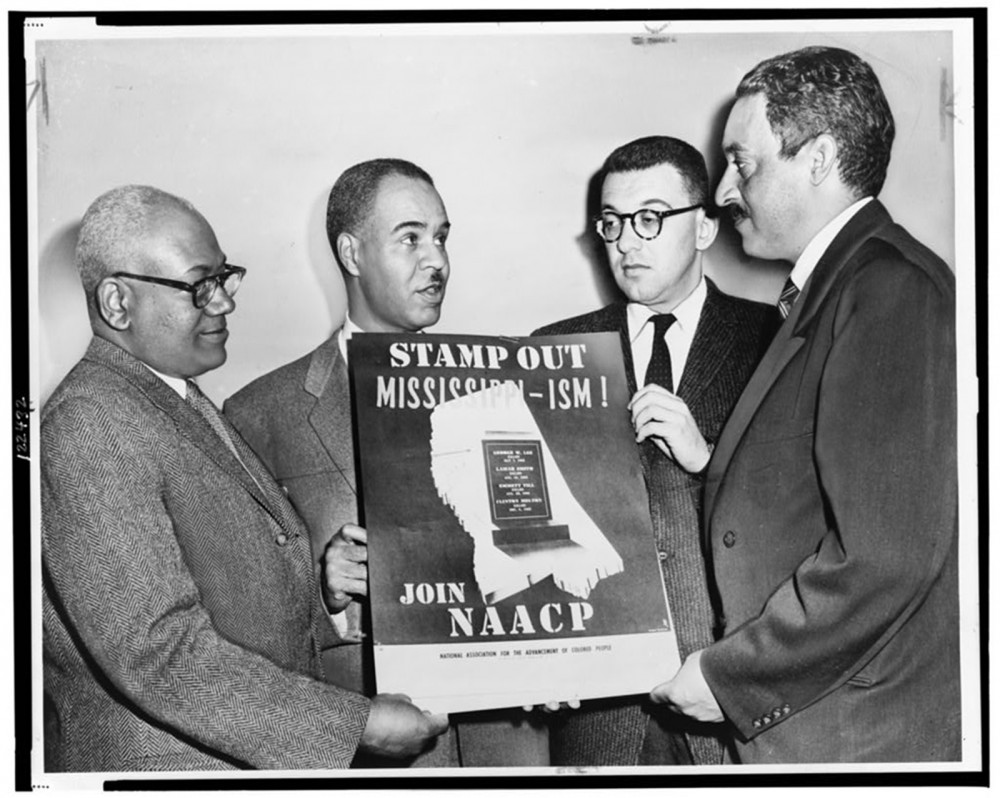
Though remembered as just one lawsuit, Brown consolidated five separate cases that had originated in the southeastern United States: Briggs v. Elliott (South Carolina), Davis v. County School Board of Prince Edward County (Virginia), Beulah v. Belton (Delaware), Boiling v. Sharpe(Washington, D. C.), and Brown v. Board of Education (Kansas). Working with local activists already involved in desegregation fights, the NAACP purposely chose cases with a diverse set of local backgrounds to show that segregation was not just an issue in the Deep South, and that a sweeping judgment on the fundamental constitutionality of Plessy was needed.
Briggs v. Elliott had illustrated, on the one hand, the extreme deficiencies in segregated Black schools. The first case accepted by the NAACP, Briggs originated in rural Clarendon County, South Carolina, where taxpayers in 1950 spent $179 to educate each white student while spending $43 for each Black student. The district’s twelve white schools were cumulatively worth $637,850; the value of its sixty-one Black schools (mostly dilapidated, over-crowded shacks), was $194,575. While Briggs underscored the South’s failure to follow Plessy, the Brown v. Board suit focused less on material disparities between Black and white schools (which were significantly less than in places like Clarendon County) and more on the social and spiritual degradation that accompanied legal segregation. This case cut to the basic question of whether or not “separate” was itself inherently unequal. The NAACP said the two notions were incompatible. As one witness before the U. S. District Court of Kansas said, “the entire colored race is craving light, and the only way to reach the light is to start [Black and white] children together in their infancy and they come up together.”
To make its case, the NAACP marshaled historical and social scientific evidence. The Court found the historical evidence inconclusive and drew their ruling more heavily from the NAACP’s argument that segregation psychologically damaged Black children. To make this argument, association lawyers relied upon social scientific evidence, such as the famous doll experiments of Kenneth and Mamie Clark. The Clarks demonstrated that while young white girls would naturally choose to play with white dolls, young Black girls would, too. The Clarks argued that Black children’s aesthetic and moral preference for white dolls demonstrated the pernicious effects and self-loathing produced by segregation. The doll experiments illustrated one psychological effect of segregation on communities of color - internalized racism, an acceptance of the racial hierarchy that places whites consistently above people of color.
Identifying and denouncing injustice, though, is different from rectifying it. Though Brown repudiated Plessy, the Court’s orders did not extend to segregation in places other than public schools and, even then, while recognizing the historical importance of the decision, the justices set aside the divisive yet essential question of remediation and enforcement to preserve a unanimous decision. Their infamously ambiguous order in 1955 (what came to be known as Brown II) that school districts desegregate “with all deliberate speed” was so vague and ineffectual that it left the actual business of desegregation in the hands of those who opposed it.
In most of the South, as well as the rest of the country, school integration did not occur on a wide scale until well after Brown. Only in the 1964 Civil Rights Act did the federal government finally implement some enforcement of the Brown decision by threatening to withhold funding from recalcitrant school districts, financially compelling desegregation, but even then southern districts found loopholes. Court decisions such as Green v. New Kent County (1968) and Alexander v. Holmes (1969) finally closed some of those loopholes, such as “freedom of choice” plans, to compel some measure of actual integration.
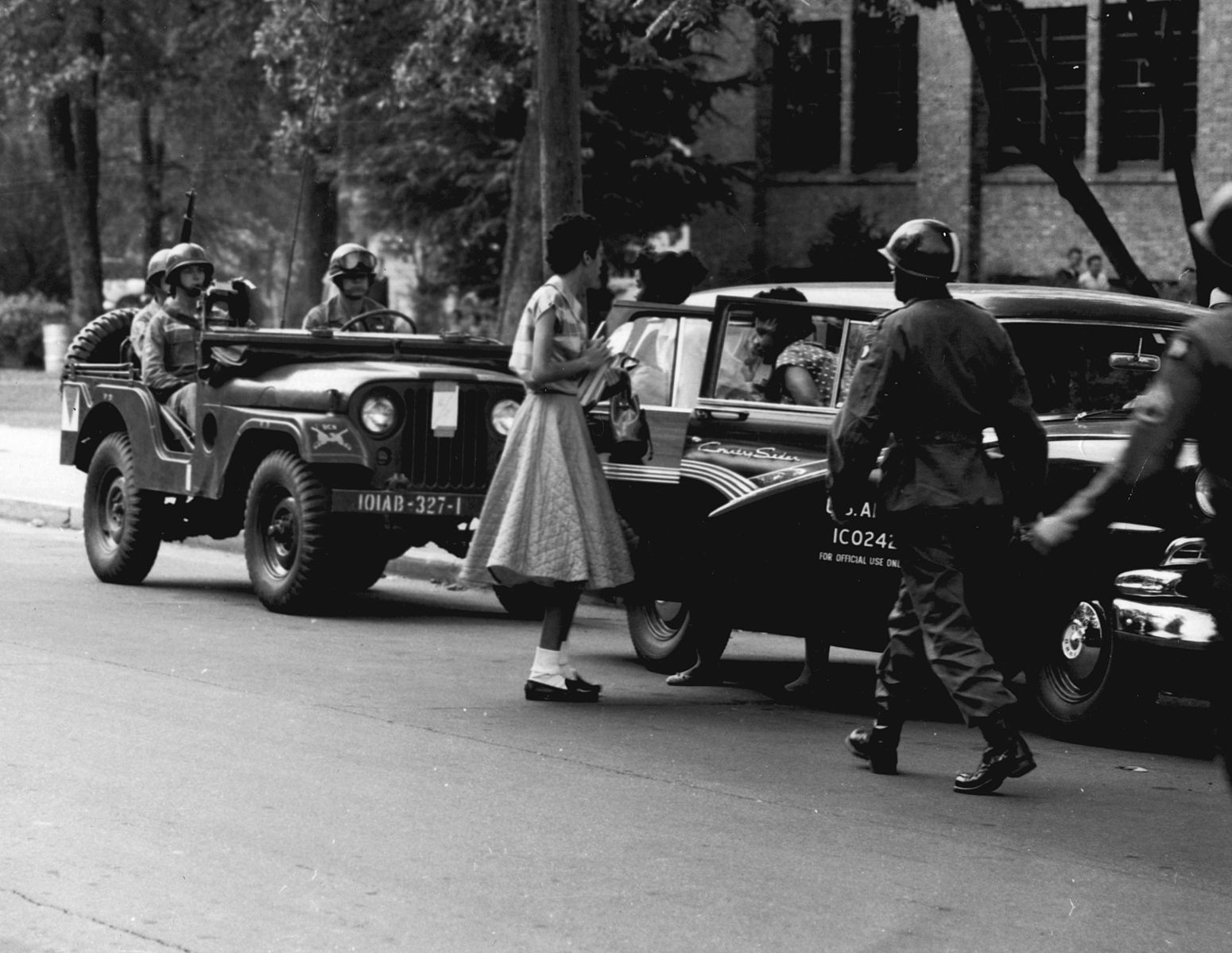
Figure \(\PageIndex{19}\): African American students who desegregated white schools, the “Little Rock Nine” (Arkansas), were escorted by, the 101st Airborne Division of the U.S. Army. (CC BY 2.0; U.S. Army via Wikimedia/Flickr)
When Brown finally was enforced in the South, the quantitative impact was staggering. In the early 1950s, virtually no southern Black students attended white schools. By 1968, fourteen years after Brown, some eighty percent of Black southerners remained in schools that were ninety- to one-hundred-percent nonwhite. By 1972, though, just twenty-five percent were in such schools, and fifty-five percent remained in schools with a simple nonwhite minority. By many measures, the public schools of the South ironically became the most integrated in the nation.
As a landmark moment in American history, Brown’s significance perhaps lies less in what immediate tangible changes it wrought in African American life—which were slow, partial, and inseparable from a much longer chain of events—than in the idealism it expressed and the momentum it created. The nation’s highest court had attacked one of the fundamental supports of Jim Crow segregation and offered constitutional cover for the creation of one of the greatest social movements in American history.
Black Nationalism
Origins of Black Nationalism
Inspired by the writings of Booker T. Washington, Jamaican-born Marcus Garvey became the most prominent Black Nationalist in the United States. He championed the Back-to-Africa movement, advocated for Black-owned businesses—he founded the Black Star Line, a transnational shipping company—and founded the Universal Negro Improvement Association (UNIA). Thousands of UNIA chapters formed all across the world. In 1921, Garvey recorded a message in a New York studio explaining the object of the UNIA, which can be understood as separatism, an effort to create an African American community in Africa - free from whites.
This section is licensed CC BY-SA. Attribution: United States History 2 (Lumen) (CC BY-SA 4.0)
Marcus Garvey, Explanation of the Objects of the Universal Negro Improvement Association (1921)
Fellow citizens of Africa, I greet you in the name of the Universal Negro Improvement Association and African Communities League of the World. You may ask, “what organization is that?” It is for me to inform you that the Universal Negro Improvement Association is an organization that seeks to unite, into one solid body, the four hundred million Negroes in the world. To link up the fifty million Negroes in the United States of America, with the twenty million Negroes of the West Indies, the forty million Negroes of South and Central America, with the two hundred and eighty million Negroes of Africa, for the purpose of bettering our industrial, commercial, educational, social, and political conditions.
As you are aware, the world in which we live today is divided into separate race groups and distinct nationalities. Each race and each nationality is endeavoring to work out its own destiny, to the exclusion of other races and other nationalities. We hear the cry of “England for the Englishman,” of “France for the Frenchman,” of “Germany for the German,” of “Ireland for the Irish,” of “Palestine for the Jew,” of “Japan for the Japanese,” of “China for the Chinese.”
We of the Universal Negro Improvement Association are raising the cry of “Africa for the Africans,” those at home and those abroad. There are 400 million Africans in the world who have Negro blood coursing through their veins, and we believe that the time has come to unite these 400 million people toward the one common purpose of bettering their condition.
The great problem of the Negro for the last 500 years has been that of disunity. No one or no organization ever succeeded in uniting the Negro race. But within the last four years, the Universal Negro Improvement Association has worked wonders. It is bringing together in one fold four million organized Negroes who are scattered in all parts of the world. Here in the 48 States of the American Union, all the West Indies islands, and the countries of South and Central America and Africa. These four million people are working to convert the rest of the four hundred million that are all over the world, and it is for this purpose, that we are asking you to join our land and to do the best you can to help us to bring about an emancipated race.
If anything praiseworthy is to be done, it must be done through unity, and it is for that reason that the Universal Negro Improvement Association calls upon every Negro in the United States to rally to this standard. We want to unite the Negro race in this country. We want every Negro to work for one common object, that of building a nation of his own on the great continent of Africa. That all Negroes all over the world are working for the establishment of a government in Africa means that it will be realized in another few years.
We want the moral and financial support of every Negro to make this dream a possibility. Our race, this organization, has established itself in Nigeria, West Africa, and it endeavors to do all possible to develop that Negro country to become a great industrial and commercial commonwealth.
Pioneers have been sent by this organization to Nigeria, and they are now laying the foundations upon which the four hundred million Negroes of the world will build. If you believe that the Negro has a soul, if you believe that the Negro is a man, if you believe the Negro was endowed with the senses commonly given to other men by the Creator, then you must acknowledge that what other men have done, Negroes can do. We want to build up cities, nations, governments, industries of our own in Africa, so that we will be able to have a chance to rise from the lowest to the highest position in the African Commonwealth.
The Nation of Islam and Malcolm X
Though most African Americans did not heed Garvey's call to return to Africa, his speeches did result in a positive impact on Black identity, lasting for decades. As tension continued to mount in cities through the 1950s and 1960s, the tone of the Civil Rights Movement (discussed in more depth in Chapter 7.5) changed yet again. Activists became less conciliatory in their calls for civil rights progress, embracing the more militant message of the burgeoning Black Power Movement and the late Malcolm X, a Nation of Islam (NOI) minister who had encouraged African Americans to pursue freedom, equality, and justice by “any means necessary.” Prior to his death, Malcolm X and the NOI emerged as the radical alternative to the racially integrated, largely Protestant approach of the Martin Luther King, Jr.-led civil rights movement. Malcolm advocated armed resistance in defense for the safety and well being of Black Americans, stating, “I don’t call it violence when it’s self-defense, I call it intelligence.” For his part, King and leaders from more mainstream organizations like the NAACP and the Urban League criticized both Malcolm X and the NOI for what they perceived to be racial demagoguery. King believed Malcolm’s speeches were a “great disservice” to Black Americans, claiming that X’s speeches lamented the problems of African Americans without offering solutions. The differences between Dr. King and Malcolm X represented a core ideological tension that would inhabit Black political thought throughout the 1960s and 1970s.
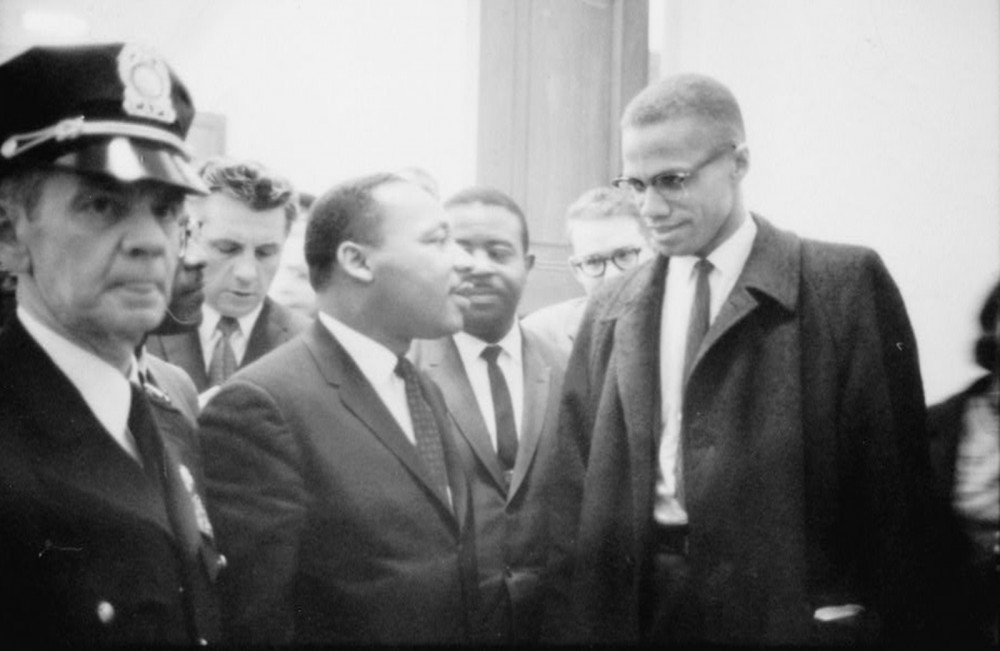
Contributors and Attributions
Content on this page has multiple licenses. Everything is CC BY-NC-SA other than Origins of Black Nationalism which is CC BY-SA.
- Johnson, Shaheen. (Long Beach City College)
- Hund, Janét. (Long Beach City College)
- An Overview of the Trans-Atlantic (Dr. David Eltis) (CC BY-NC 3.0 US)
- United States History 1 (Lumen) (CC BY 4.0)
- United States History 2 (Lumen) (CC BY-SA 4.0) (Contributed to Origins of Black Nationalism)
- Jim Crow Laws/Segregation Introduction (OER Commons) (CC BY-NC-SA 4.0)
- The Tulsa Race Massacre (Oklahoma Historical Society/OER Commons) (CC BY-NC-SA 4.0)
Works Cited
- Garvey, M. (1921). Explanation of the objects of the universal negro improvement association. Marcus Garvey and the UNIA Papers Project at the University of California, Los Angeles.
- Holt, Hamilton. (1906). The Life Stories of Undistinguished Americans as Told by Themselves. Abingdon, UK: Routledge.
- IBW21. (2017). The Story of Marcus Garvey: A Documentary. [Video]. YouTube.
- Lott, E. (1993). Love and Theft: Blackface Minstrelsy and the American Working Class. New York,NY: Oxford University Press.
- Macat. (2015). An Introduction to W.E.B. Du Bois' The Souls of Black Folk-Macat Sociology Analysis. [Video].
- Merenda, C. (2015). Kenneth and Mamie Clark: A Biographic Video. [Video]. YouTube.
- Niagara Movement. (n.d.). Encyclopedia Britannica.
- Quimbee. (2017). Plessy v. Ferguson Summary. [Video]. YouTube.
- Takaki, R. (2008). A Different Mirror: A History of Multicultural America. New York, NY: Back Bay Books.
- The Atlantic. (2018). How Does It Feel to Be a Problem? [Video]. YouTube.
- TRT World. (2020). Who was Malcolm X? [Video]. YouTube.
- Woodward, V.C. (1955). The Strange Career of Jim Crow. New York, NY: Oxford University Press.

